#592 Hamlet of Oberon
Credit: January 31, 1997
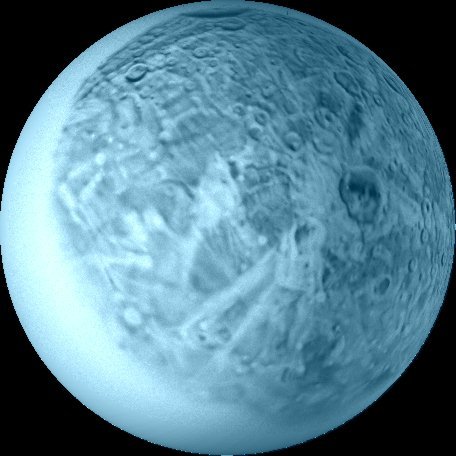
“What's in a name? Since 1919, the International Astronomical Union has been charged with the task of establishing "conventional" nomenclature for planets, satellites, and surface features. For the remote Uranian system of moons, namesakes from Shakespearean works have been chosen. Thus Oberon, king of the mid-summer night fairies, is also Uranus' most distant and second largest moon and Hamlet is a tragically large and princely crater on its surface. The above image represents known surface features of Oberon and was constructed by the U.S. Geological Survey (USGS) based on data from NASA's robot explorer Voyager 2. Hamlet is the large dark crater to the right of center. In 1986, Voyager 2 flew through the Uranian system - so far it has been the only spacecraft to do so."
Copyright: Public domain
#593 Catching Falling Stardust
Credit: February 01, 1997
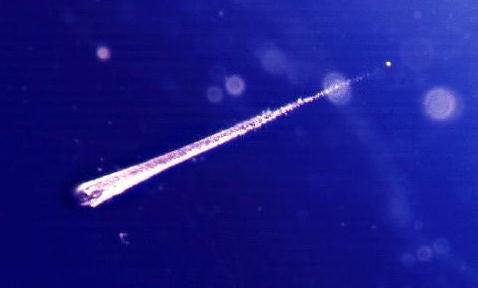
“This carrot shaped track is actually little more than 5 hundredths of an inch long. It is the trail of a meteroid through aerogel exposed to space by the shuttle launched EURECA (European Recoverable Carrier) spacecraft. The meteoroid itself, about a thousandth of an inch in diameter, is visible where it came to rest, just beyond the tip of the carrot (far right). Chemical analyses of interplanetary dust particles similar to this one suggest that some of them may be bits of comets and represent samples of material from the early stages of the formation of the Solar System. NASA's Stardust mission, planned for launch in 1999, will attempt to directly collect dust from the tail of a comet and return it to Earth -- the first non-lunar sample return mission ever! In addition to peering into the chemistry and history of the solar system, the composition of cometary dust has important implications for the possibility of past life on Mars."
Copyright: Public domain
#594 Standing on the Moon
Credit: February 02, 1997
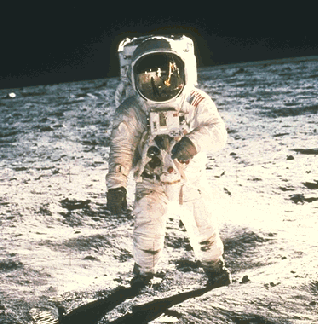
“Humans once walked on the Moon. Pictured above is the second person to stand on the lunar surface: Edwin "Buzz" Aldrin. During this Apollo 11 mission, Neil Armstrong (the first person to walk on the moon) and Buzz Aldrin landed on the Moon while Michael Collins circled in the Command Module above. The lunar team erected a plaque on the surface that reads: HERE MEN FROM THE PLANET EARTH FIRST SET FOOT UPON THE MOON JULY 1969 A.D. WE CAME IN PEACE FOR ALL MANKIND. The Apollo missions demonstrated that it is possible to land humans on the Moon and return them safely. "
Copyright: Public domain
#595 Stars Without Galaxies
Credit: February 03, 1997
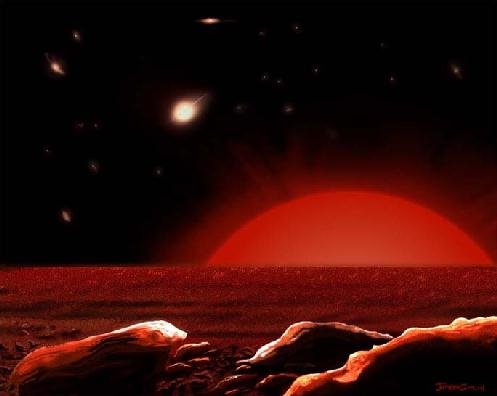
“Galaxies are made up of stars, but are all stars found within galaxies? Apparently not. Using the Hubble Space Telescope, researchers exploring the Virgo Cluster of galaxies have now found about 600 red giant stars adrift in intergalactic space. Above is an artist's vision of the sky from a hypothetical planet of such a lonely sun. The night sky on a world orbiting an intergalactic star would be a stark contrast to Earth's - which features a nightly parade of stars, all members of our own Milkyway galaxy. As suggested by the illustration, a setting swollen red sun would leave behind a dark sky speckled only with faint, fuzzy, apparitions of Virgo Cluster galaxies. Possibly ejected from their home galaxies during galaxy-galaxy collisions, these isolated suns may well represent part of a large, previously unseen stellar population, filling the the space between Virgo cluster galaxies."
Copyright: Public domain
#596 Clyde W. Tombaugh: 1906-1997
Credit and Copyright: February 04, 1997
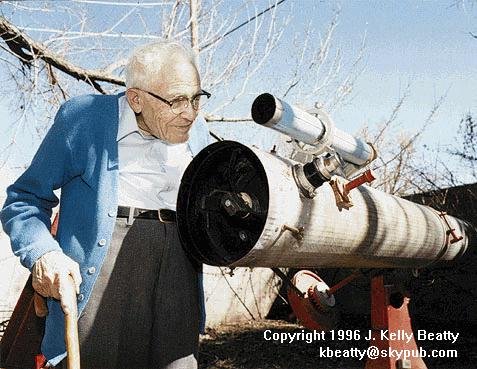
“Astronomer Clyde Tombaugh, discoverer of Pluto, died on January 17th. Inspiring many during his long and exceptional career, he had been living in Las Cruces, New Mexico with his wife of 60 years, Patsy. Today would have been his 91st birthday. He is pictured above in 1995 in his backyard with a telescope he knew well - a 9 inch Newtonian reflector he built in 1927 with discarded farm machinery and car parts. Using this telescope under the dark night skies of Western Kansas, he made drawings of Mars and Jupiter and submitted them to Lowell Observatory in 1928. Hired to work at Lowell in 1929, Tombaugh embarked on a systematic photographic search for the long sought Planet X with a newly constructed 13 inch astrograph. In 1930 Tombaugh triumphed in his struggle to find the 9th planet, discovering faint and distant Pluto orbiting at the edge of our Solar System. Founding father of New Mexico State University's Astronomy Department, he retired as professor emeritus in 1973 but continued to tour as a lecturer and promoter until failing health prevented it. Always an active stargazer, he was asked by the Smithsonian if they could have the telescope he used to make his 1928 drawings. His response: "I told them I was still using it.""
Copyright: Public domain
#597 Running Red Rings Around Jupiter
Credit: February 05, 1997
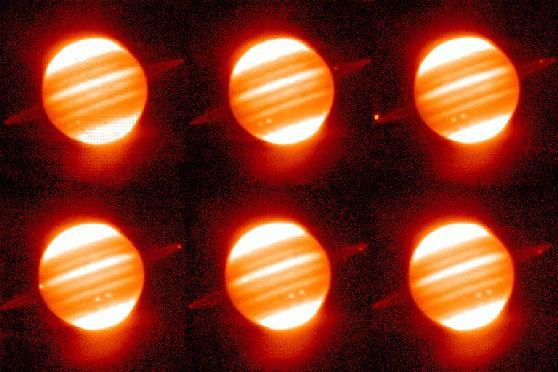
“Jupiter has rings, too. Unlike Saturn's bright rings which are composed of chunks of ice, Jupiter's rings are darker and appear to consist of fine particles of rock. The six pictures above were taken in infrared light from the Infrared Telescope Facility in Hawaii in 1994, and cover a time span of two hours. Quite visible are Jupiter's rings, bands and spots in the outer atmosphere. Also visible in the photos, however, are two small Jovian moons. Metis, only 40 kilometers across, appears in the second picture as a dim spot on the rings to the right of Jupiter. Amalthea, much larger and brighter, appears in the third frame on the far left, and can be seen to pass across the face of Jupiter in frames four and five. The origin of Jupiter's rings remains unknown, although hypothesized to be created by material scattered from meteorite impacts onto Jupiter's moons. "
Copyright: Public domain
#598 Comet Hale-Bopp Returns
Credit and Copyright: February 06, 1997
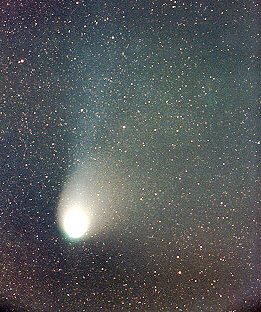
“Comet Hale-Bopp has returned from behind the Sun. In December and early January, Comet Hale-Bopp was too near the Sun to be easily visible from Earth. Now the comet graces the morning sky and is visible from dark locations even without binoculars. The above photo was taken on January 31st and shows the two emerging tails of Comet Hale-Bopp. The blue wisp pointing up is the ion tale, while the white fuzz is the dust tail. On its trip to the inner Solar System, Comet Hale-Bopp is once again showing signs it could brighten in the next few months to become the most spectacular comet in modern times. "
Copyright: Public domain
#599 M1: Filaments of the Crab Nebula
Credit and Copyright: February 07, 1997
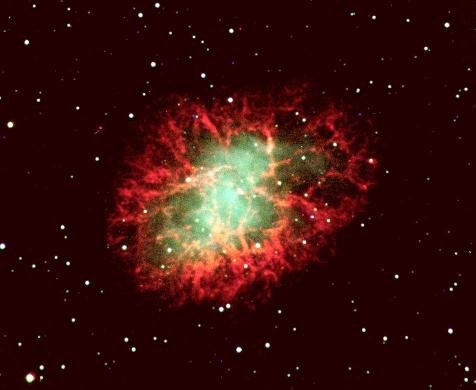
“The Crab Nebula is filled with mysterious filaments. The Crab Nebula is the result of a star that exploded in 1054 AD. This spectacular supernova explosion was recorded by Chinese and (quite probably) Anasazi Indian astronomers. The filaments are mysterious because they appear to have less mass than expelled in the original supernova and higher speed than expected from a free explosion. In the above picture, the color indicates what is happening to the electrons in different parts of the Crab Nebula. Red indicates the electrons are recombining with protons to form neutral hydrogen, while green indicates the electrons are whirling around the magnetic field of the inner nebula. In the nebula's very center lies a pulsar: a neutron star rotating, in this case, 30 times a second."
Copyright: Public domain
#600 M104: The Sombrero Galaxy
Credit: February 08, 1997
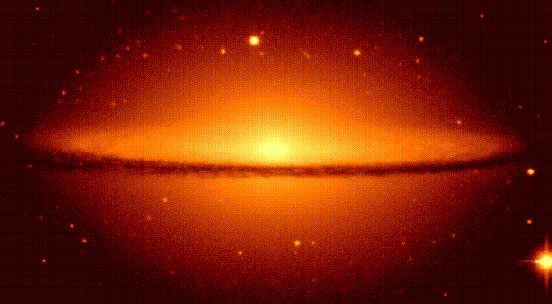
“The famous Sombrero galaxy (M104) is a bright nearby spiral galaxy. The prominent dust lane and halo of stars and globular clusters give this galaxy its name. Something very energetic is going on in the Sombrero's center, as much X-ray light has been detected from it. This X-ray emission coupled with unusually high central stellar velocities cause many astronomers to speculate that a black hole lies at the Sombrero's center - a black hole a billion times the mass of our Sun. "
Copyright: Public domain
Upvote! Resteem! Comment! As you like it! Thank you for attention!
Curious?
introduction post
introduction post
Check out the great posts I already resteemed.Resteemed by @resteembot! Good Luck! The @resteembot's The @reblogger's Get more from @resteembot with the #resteembotsentme initiative
Congratulations @george-zagraid! You have completed some achievement on Steemit and have been rewarded with new badge(s) :
Click on any badge to view your own Board of Honor on SteemitBoard.
For more information about SteemitBoard, click here
If you no longer want to receive notifications, reply to this comment with the word
STOP